KITPLANES - September 2006 - Las Vegas Quickie
- Details
- Category: Magazine Articles
- Published: Monday, 31 October 2011 10:49
- Written by Ed Wischmeyer
- Hits: 17406
by Ed Wischmeyer
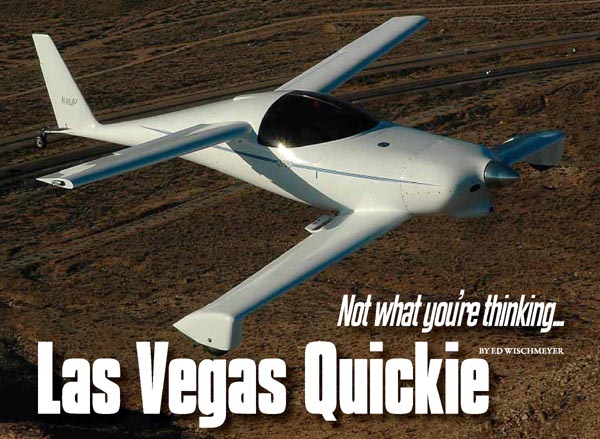
Jean, Nevada, 20 miles south of Las Vegas, is a wide spot in the road with an unspectacular casino right next to the airport. It’s just the place to get a Quickie —or at least a ride in one. In the heat of the moment, it’s easy to ignore technicalities, so in the afterglow I’ll admit that this was not just a Quickie but a Q200—a fast, compact, nifty, thrifty, but not shifty cross-country cruiser.
Like many romances, this meeting came by chance. The occasion? The Alternative (Aircraft) Engine Roundup, formerly the tandem-wing fly-in, where attending Q2s, Q200s and Dragonflies outnumbered Cessnas eight-to-three.
Maybe you’ve just come to our part of aviation, so the first question might be: What’s a Q200? In the beginning was the Rutan VariEze, which begat many offspring, such as the single-seat Quickie. The Quickie begat the two-seat Q2, designed by Tom Jewett and Gene Sheehan; Rutan at the time was no longer with the project. At about the same time, the slightly larger Dragonfly came into being. Then the Q2 factory went bankrupt in 1986 after being sued by a builder after an accident, according to www.quickiebuilders.org. Later came the Q200, a Q2 with an 0-200 engine up front and a different canard.
Technically, the Quickie (and Q2 and Q200) are orphaned designs, with kits no longer made and no plans available. However, there is a sizable builder’s group and many kits are in the field—the Quickie Builders group estimates there were 1000 Quickie and 2000 Q2/Q200 kits sold—so keep watching the classifieds.
What's Not To Like?
Then, as now, a principle attraction of the Q200 is speed. How about 165 knots (190 mph) as a cruise figure for a clean one with a mildly tricked Continental 0-200 engine?
Consider, too, that the little engine, so long a mainstay of the Cessna 150 fleet, is burning a bit more than 6 gph to do so.
And the ride in turbulence is supposed to be real good, with only 68 square feet of wing(s) giving a high wing loading of nearly 20 pounds per square foot. Short field and high density altitude capabilities? Well, uh, how ’bout that high cruise speed and good ride in turbulence?
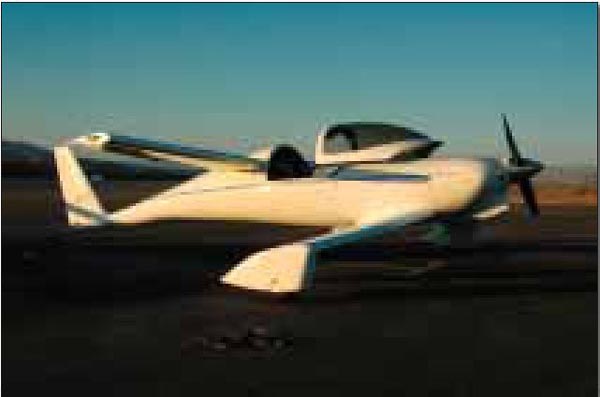 |
| The main wheels are at the tips of the front wing, nav lights and strobes at the tips of the aft wing. “Elevators” are on the front wing. Typical Q200, in other words. |
You’ve heard that all airplanes are compromises, and the Q200, as much as any airplane can be, is a point design—great for fast, economical cross-country, but as for short fields, forget it. The speed on short final is a crisp 80 knots, faster than a Cessna 210, and up there with some twins. Why? You can’t have a highly loaded wing with no flaps and expect it to fly at the low speeds needed for short fields. Plus, the angle of attack of the main wing on the ground is only 7°, half the angle for maximum lift.
The other operational point of the Q200 is forward visibility. It’s OK on the ground, fine in cruise, but like many other planes, poor in climb. The seating position is recumbent, and your eyes aren’t that far above the cowling. So, with any amount of nose up, there goes your visibility. And, with the relatively high cockpit walls and no windows aft of the canopy, runways on the other side of the airplane just disappear, like in some other airplanes.
Paying Dues
When the Q2 came out, it was promoted as fast and easy to fly. And all that is true, sort of. If you’ve paid your dues, and if the appropriate mods are on the plane, no problem. If not, well, those weeds off to the side of the runway are licking their little green chops.
Dues? Get time in something like an old AA-1 Yankee to get used to more sensitive controls and higher landing speeds. And, make friends with a Citabria, preferably from the back seat and get weaned from expecting to see forward all the time.
With this kind of flight experience, you’ll be ready, but make sure that your Q2/200 has the appropriate mods. The original Q2 design had a few problems. One was that the original forward wing with the GU (Glasgow University) airfoil was susceptible to surface contamination. With a few bugs or raindrops, it would lose lift, and the airplane would pitch down. Vortex generators fixed that problem, though.
The GU airfoil was originally chosen, says Q200 owner and guru James Patillo, because it had been wind-tunnel tested and its properties were documented. The later Q200 used an NASA LSI airfoil on the forward wing, with lots of camber on the aft undersurface—as a result, it suffered no surface contamination problems and brought 2 knots more speed.
More tricks: Those unusual tabs on the inboard end of each elevator on the front wing are “sparrow strainers.” They keep the elevators from floating up with air pressure and compromising the airfoil shape.
Rudder, What Rudder?
Another design issue was that the rear wing at speeds between, say, 30 and 55 knots, would still be developing lift and keeping weight off the tailwheel, regardless of what you did with the elevators, which are on the front wing. So, you’d enter a regime with no weight on the tailwheel and with the airspeed too low for that tiny rudder to do anything. Hello, weeds!
Lastly, in the original design, the rudder cables went straight to the tail-wheel, and other cables went forward from the tailwheel to the rudder. (Tension on the left rudder cable would pull the tailwheel to the left, tensioning the right auxiliary cable, which would pull back on the right side of the rudder, causing it to deflect to the left.) A clever design, but with a prob-lem—if the tailwheel spring broke, and it was fragile, you’d have complete slack in the rudder cables—no rudder, no tailwheel steering. And, with a center brake lever operating both wheels at once, it was, you guessed it, hello, weeds!
Patillo and Bob Farnam, both longtime members of the Q2/200 community, told me about the “Jim Bob Six Pack” required mods for tailwheel Q2/200s. They include: the AirProducts tailwheel assembly; a new tailwheel spring; toe brakes; a bellcrank to actuate separate cables to the rudder and to the tailwheel; aileron reflex, so that after landing, you can reduce lift on the rear wing; and four-point brake caliper suspensions that don’t bind. With all these mods in place, you can greet the weeds on your terms, not theirs.
Taming ground handling is a matter of using these modifications, but additional checks include the landing gear alignment, and there’s an interesting way to do this. When sighting through one axle, you should see a point 2 inches forward of the other axle. Because the wheels are 200 inches apart, this is a toe out on each wheel of one part
in 100, or about 1.5°. Some Q2/200s also had positive camber on the main wheels, which should be corrected.
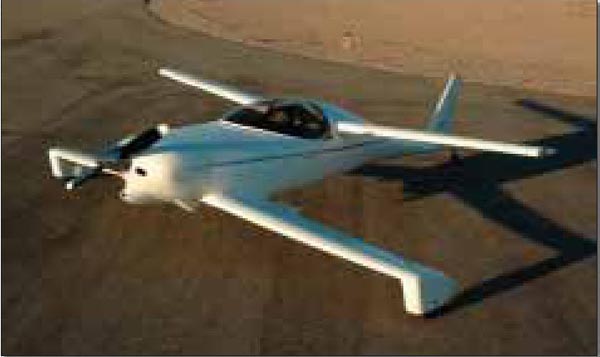 |
| Sleek, gorgeous and ready for the Nevada morning air. On the trailing edge of the front wing next to the fuselage is a “sparrow strainer” to keep the cambered elevators pushed down and help the front wing generate lift.
|
Weight For It
The Q200 has another limitation— weight and balance. The 0-200 engine is so much heavier than the original VW derivative engines that it has to be nestled tight up against the firewall. How tight? If you want to time the mags, you have to pull the engine. That’s why Patil-lo’s plane has dual Lightspeed Plasma III electronic ignition systems.
Patillo’s engine also has Superior cylinders that have been ported, polished, and flow balanced. He has dynamically balanced his propeller virtually to perfection, as well.
Possible alternatives to the Continental include the six-cylinder Jabiru—one is being installed in a Q200—but it’s really not heavy enough. However, the Jabiru’s light weight would allow a con-stant-speed prop, helpful for improved takeoff and climb performance. Trigear Q200s can also handle a constant-speed
prop, because they don’t have to keep weight on a tailwheel.
Hope It Floats
The Q2/Q200 have one novel emergency procedure, however. In case of an engine failure, with that 80-knot approach speed, the preferred forced landing area is water. The tailwheel planes don’t flip over in a water landing, and they float, making a water landing preferable to head-butting rocks and weeds. As we flew over the Nevada desert, where the only water was brown and in artificial rectangular ponds, clustered in threes and sixes, sometimes with patterned aeration bubbles...
But even in an off-field landing, the Q2/Q200 is apparently one of the more crashworthy designs out there. The engine and lower wing absorb the impact ahead of the cockpit and decelerate the airframe, and passengers just walk away.
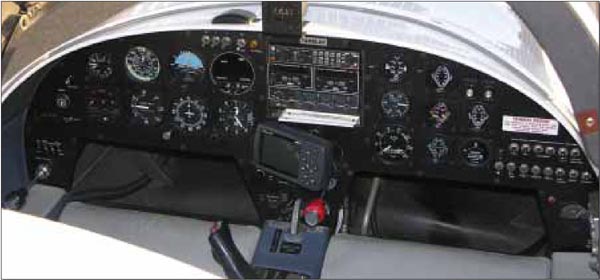 |
| The tidy instrument panel is set up for cross-country flying with the center stick and trim tab wheel ahead of it. That's the throttle on the far left. |
Get On Board
With ground and air-to-air photos finished, we boarded Patillo’s Q200 for a flight evaluation. Boarding the Q200 is graceless, as with some other homebuilts. Take a giant stretch over the side of the cockpit and step on a towel on the seat. Put one hand on the fuselage behind the cockpit, but don’t touch the canopy. Face forward and slither your legs under the panel.
The recumbent seating position is comfortable, and there was enough headroom for my tall torso—just. To turn my head to the right, it helped to move it back towards the center of the plane.
Legroom was abundant with no rudder pedals on my side. There’s enough room on the outside, but the center of the airplane will make you wish for the roominess of airline coach-class seats. Startup and taxi were cooled by the prop blast as Patillo kept the canopy open. It came closed during runup as Patillo followed his laminated checklist.
At the start of the takeoff roll, the engine turned only 2250 rpm. Acceleration was reasonable on takeoff with the good power-to-weight ratio, but the cruise prop and 3000-foot elevation took their toll. We lifted off at 70 knots indicated, having used three times the runway my old Cessna 175 required.
We climbed up to altitude at 80 knots and 500 fpm, with the center stick providing appropriate moderate control pressures, just right. Turns at 100 knots indicated
required obvious back pressure, some opposite aileron, and a little bit of rudder, which I didn’t have. I think that flying the Q200 really well would require just enough finesse to be very satisfying.
Previously, Patillo celebrated the end of the air-to-air photo mission with an aileron roll with a lot of nose up and only a moderate roll rate. It’s better than being stuck straight and level all the time, but yankin’ and bankin’ does not look like a Q200 strong suit.
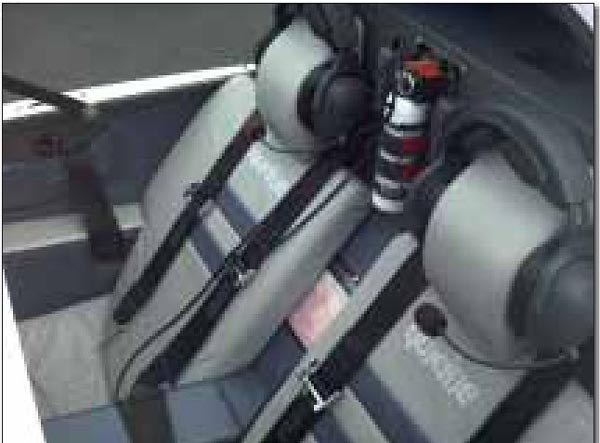 |
| Patillo's interior is beautifully finished and comfortable. Headroom is OK for the tall-torsoed, but the center armrest is shared space. Play nice. |
No Conventional Stalls
One supposed advantage of the tandem wing design is that, properly designed and built, it won’t stall in the conventional sense. Even so, the Q200 stall didn’t seem as benign as my ancient Cessna with a STOL kit.
Not to say the Q200’s stall includes an abrupt break—rather, it’s a pitch oscillation like other planes if you hold the stick back continuously after stall break to let an oscillation develop. However, Q200 stall oscillations have less amplitude than in most conventional aircraft; and second, the start of each oscillation is annunciated with a distinct and obvious rap on the stick as the front wing stall impacts the elevators on the front wing. There were no directional control problems, even though I had no rudder pedals and half power.
The elevator trim was less than satisfactory, however. In Patillo’s plane, it’s set up with a lot of friction to keep it from working lose—and located in the center console ahead of the stick—so you have to reach over with your other hand to adjust it. Watch for this shortcoming on any Q200 you’d like to buy.
As we let the speed build up and the engine revved above 2400 rpm, there was obvious vibration and a sound like being in a twin-engine airplane with the propellers out of synch. Patillo has worked to find a fix but success eludes him. As many do with 0-200s that are carefully tended, Patillo cruises above the 2700-rpm redline to get that 165-knot (190-mph) cruise. If that sounds harsh, consider that it’s still well below the speeds inflicted on this engine design by Reno racers.
Patillo flew the landing back at Jean, reclaiming the coveted center console space. The belly board came out at 95 knots on downwind, and he flew a gentle pattern appropriate to our speed. Nailing 80 knots over the fence, and on through the rollout, Patillo picked up directional cues from only his edge of the runway. Patillo wasn’t working for a short landing, so we used up a good 3000 feet of runway. His personal minimums are 2200 feet of runway at least 50 feet wide.
Patillo’s plane reflects the 4000 hours of construction time and is gorgeous. Part of that long build time is because there was no factory support and no Internet during the construction period. In fact, Patillo and Farnam were only but a few miles apart when building, but neither knew of the other. There is now an Internet support group, and the builders at Jean all seemed enamored of their aircraft.
As with any homebuilt, and especially with a design that has been orphaned for a number of years, you’ll need to be real careful buying one, completed or a kit under way. But if you make the mods and don’t need short field or high density altitude capabilities, the Q200 is one fine little cross-country airplane. +
For a direct link to the Quickie Builders Association web site, visit www.kitplanes.com.
|
Q200 |
|
Typical used price.........................................$15,000 - $40,000 |
|
Estimated build time...................................2000 - 4000 hours |
|
Number flying (at press time)..........................................100+ |
|
Powerplant..................................................Continental O-200 |
|
Propeller.......................................Cato two-blade fixed-pitch |
|
Powerplant options.................................................80 - 100 hp |
|
|
|
Wingspan...................................................................16 ft 8 in |
|
Wing loading......................................................16.40 lb/sq. ft |
|
Fuel capacity....................................................................20 gal |
|
Maximum gross weight................................................1325 lb |
|
Typical empty weight......................................................760 lb |
|
Typical useful load...........................................................565 lb |
|
Full-fuel payload............................................................448 lb |
|
Seating capacity......................................................................2 |
|
Cabin width....................................................................43.5 in |
|
Baggage capacity..............................................................35 lb |
|
|
|
Cruise speed..........................185 - 190 mph (161 - 165 kt) TAS |
|
Maximum rate of climb.............................................1500 fpm |
|
Stall speed (landing configuration)............73 mph (63 kt) IAS |
|
Stal l speed (cl ean).......................................73 mph (63 kt) IAS |
|
Takeoff distance............................................................1000 ft |
|
Landing distance...........................................................2000 ft |
|
|



